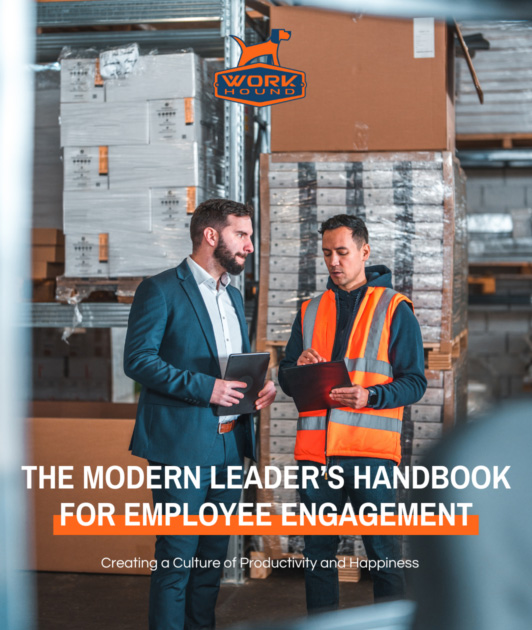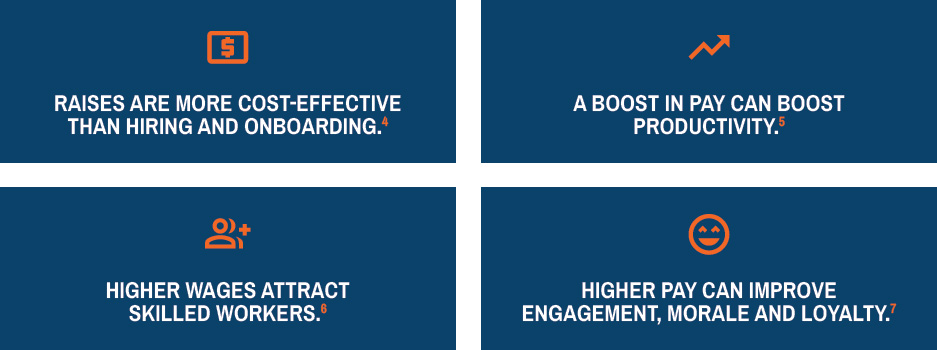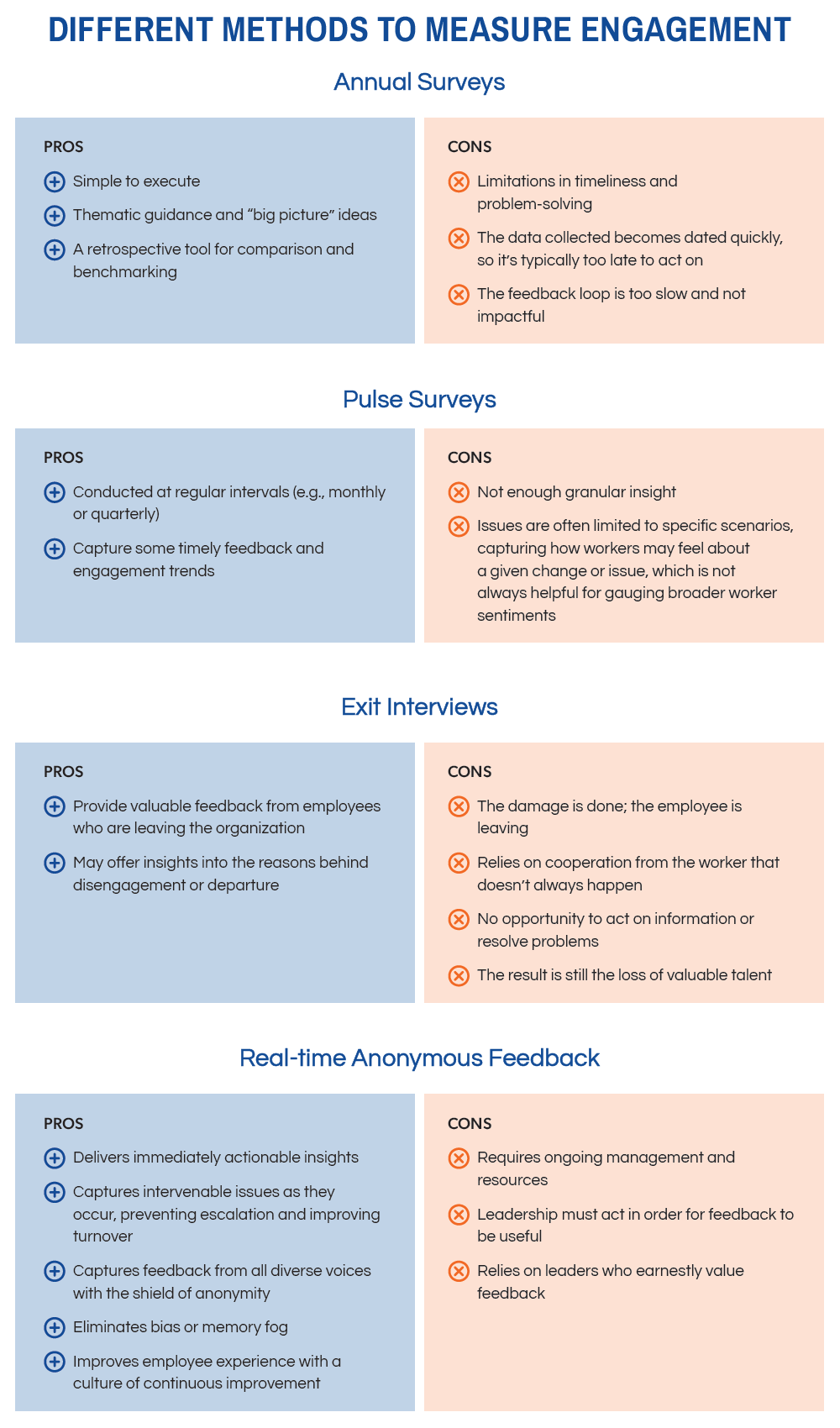The Modern Leader’s Handbook for Employee Engagement
Creating a Culture of Productivity and Happiness

Build a Culture of Excellence with a Strategic Employee Engagement Strategy
Cultivate an environment where employees are engaged, motivated, and happy. This comprehensive handbook provides actionable insights and proven strategies for modern business leaders. Download your own copy, or read the online version below.
What You’ll Learn
- Discover how leadership styles impact engagement and how to create a workplace that fosters true connection across teams.
- Unlock the secrets of transparent communication and learn how to build channels that empower your workforce.
- Understand how to measure engagement effectively and why traditional engagement methods might not be giving you the full picture.
Introduction
What is Employee Engagement?
Employee engagement plays a vital role in shaping the success of modern workplaces. And that’s not just a platitude—it’s backed by data. Studies show that highly engaged workplaces consistently outperform those with low engagement across many key business metrics.
“Employers must actively cultivate a company culture where employees feel connected, valued, and motivated.”
Recognizing the role engagement plays in business success, employers must actively cultivate a company culture where employees feel connected, valued, and motivated. This handbook is here to help. With this comprehensive guide, you’ll learn how to leverage various leadership styles to improve employee engagement, build a company culture that naturally drives employee engagement, and create transparent communication channels that empower your workforce and support your business goals.
The guide to having engaged employees
- Chapter 1: Understanding Employee Engagement
Explore the various dimensions of employee engagement, distinguish between engagement and satisfaction, and understand the impact of engagement on the workforce. - Chapter 2: The Role of Leadership in Employee Engagement
Learn how leadership styles shape employee engagement and how feedback can be used as a valuable tool for both business insights and company culture. - Chapter 3: Creating a Culture of Engagement
Unpack the link between company culture and worker engagement. Gain strategies for cultivating an engaged workplace and supporting frontline workers. - Chapter 4: Communication: The Foundation of Engagement
Learn how to optimize channels for feedback by leveraging anonymity for trust. Explore active employee listening and how to build an action plan for building a feedback loop. - Chapter 5: Measuring Employee Engagement
Discover how to measure success and dive into the drawbacks of traditional approaches like annual surveys, exit interviews, and pulse surveys. - Chapter 6: Better Business Outcomes with Engagement
Discover how to make investments in employee well-being, growth opportunities, and operational intelligence with engagement. - Chapter 7: Better Engagement with WorkHound
Learn how to leverage real-time anonymous feedback to build better workplaces, improve business outcomes, and foster greater employee happiness.
Chapter 1: Understanding Employee Engagement
Dimensions of Worker Engagement
Notable organizational psychologist and professor William A. Kahn is known for his research on the drivers of employee engagement and work-related well-being. In some circles, Khan is considered the founding father of the employee engagement model. He is credited with developing the concept of “personal engagement,” a construct wherein employees actively align their true selves with their work roles. For enhancing employee engagement, well-being, and organizational success, Khan recommends understanding and addressing three psychological dimensions.
Cognitive Engagement
Refers to employees who are mentally invested in their work. They think about their tasks, take initiative, and find ways to contribute meaningfully to their team and organization’s goals.
- Emotional Engagement
Focuses on the emotional connection that employees have with their work and organization. Emotionally engaged employees feel a sense of pride, loyalty, and belonging and genuinely care about the success of the company. - Physical Engagement
Involves employees’ active participation in physical activities or tasks related to their work. This can include hands-on involvement, teamwork, and active collaboration to achieve common goals.
Employees become fully, workers when they experience a combination of deep concentration on their tasks (cognitive), positive emotional connection to their work (emotional), and active involvement (physical). This holistic approach to measuring employee engagement suggests that employees who experience these dimensions are more likely to find their work meaningful, feel a sense of fulfillment, and contribute positively to their organizations.
“The most effective leaders are the ones who go into an organization they’ve acquired, or one they’ve been hired into as a new leader, and they just discover and learn as much as they can about what works and what doesn’t work well. They honor the expertise and knowledge and wisdom of the people who are clearly effective in their roles.”
– William Kahn, Professor and Chair of Management and Organization, Questrom School of Business
Examples of How to Engage Workers Through These Dimensions
Cognitive Engagement
- Provide Autonomy: Encourage employees to take ownership of their tasks and decisions, allowing them to use their creativity and critical thinking skills.
- Open Dialogue: Foster an environment where employees can openly share their thoughts, ideas, and concerns, promoting active mental engagement.
- Professional Development: Offer opportunities for skill development and learning to stimulate continuous cognitive growth.
- Establish Clear Objectives: Set clear goals and expectations to guide employees’ thought processes and ensure they understand their contributions’ impact.
Emotional Engagement
- Recognition and Appreciation: Regularly acknowledge employees’ efforts and achievements, making them feel valued and appreciated.
- Quality Leadership: Cultivate leaders who are empathetic, approachable, and encourage emotional connection among team members.
- Supportive Culture: Build a culture that promotes mutual support, camaraderie, and a sense of belonging among colleagues.
- Meaningful Work: Ensure that employees understand how their roles contribute to the organization’s larger purpose and goals.
- Work-Life Balance: Promote a healthy work-life balance, reducing stressors that can negatively impact emotional well-being.
Physical Engagement
- Collaborative Environment: Design workspaces and team structures that encourage teamwork and collaboration, fostering physical engagement.
- Team Building Activities: Organize team-building exercises and activities to promote active participation and camaraderie.
- Cross-Functional Projects: Assign projects that require employees from different departments to work together, promoting collaboration.
- Provide ergonomic workspaces: Ensure that employees have comfortable and well-equipped workspaces that support their physical well-being. For frontline workers this can extend to driving equipment, travel accommodations, and workspace stations.
- Recognize and reward physical effort: Acknowledge and appreciate employees’ physical efforts and contributions.
By recognizing and addressing these dimensions of employee engagement important enough, modern leaders can create a workplace environment where employees experience deep concentration, emotional connection, and active involvement in their work. This approach drives personal well-being and enhances engagement levels and organizational success.
Engagement and Generational Differences
It’s crucial to build your own employee engagement program and strategies around the workforce you have, and always recognize exactly who you’re talking to. Millennials are quickly surpassing baby boomers as the largest segment of workers, making it important to build a workplace culture that resonates with their perspective. But they’re not the only perspective to consider.
As older Americans age, only 39% aged 50 to 64 think they have enough money for retirement. This means many of them to remain in the workforce.
When it comes to expectations, it’s important to understand what different cohorts of the workforce value in their work experience. According to Gallup research, millennials are more likely to acknowledge that they’ve had someone talk to them about their progress, they’ve been given development opportunities, and they’ve had opportunities to learn and grow.
On the other hand, Gen X and baby boomers are more likely to report knowing what is expected of them in their roles, that they get to do what they do best, and that they have access to the necessary materials and equipment for their work.
These are two very different perspectives. While millennials are focused on career development and growth, older generations prioritize the value of their specific roles and responsibilities. Considering the dynamics at play and stages of their lives, younger workers are more likely to be facing ongoing change, while older workers are generally settling into the routine of stability.
As you build your strategy for engagement, keep these differences in mind, leaving room to consider unique needs, including opportunities for development, meaningful recognition, and fostering social connections.
Chapter 2: The Role of Leadership in Employee Engagement
Understanding Leadership’s Impact
Effective leadership results in healthy employee engagement. The converse is true: Ineffective leadership is typically associated with employee disengagement and its repercussions on productivity and performance. Leadership and performance management styles, communication approaches, and team dynamics all play a role in the organization’s mission.
Different leadership styles significantly influence employee engagement levels. In fact, one study showed that managers account for at least 70% of the variance in employee engagement scores. While there are multitudes of sub-styles, variations, and personality types, for our explorations in engagement, we’ve broadly categorized leadership styles into three types:
- Autocratic Leadership: This style involves centralized decision-making focused on efficiency with limited employee involvement.
- Transformational Leadership: Transformational leaders inspire and motivate their team members by setting a compelling vision and providing support and guidance for achieving it together.
- Servant Leadership: Servant leaders prioritize the needs of their employees and focus on fostering their personal growth and development.
While autocratic leaders may deliver efficiencies in production, they can struggle to engage workers beyond a task level. In contrast, transformational and servant leadership starts by considering the worker experience first. For transformational leaders, this means involving them in the goal setting, including workers in the mission, vision, and values of the company, and tying personal performance goals back to the broader company vision. Servant leaders take personalization a step further, starting with the needs of the employee, and focusing on fostering personal growth and development that will better serve the entire organization.
For employee engagement efforts that drive healthy company culture, it’s crucial to keep these qualities in mind as you hire and promote employees for leadership roles.
Embracing Feedback for Growth
Feedback is a cornerstone of effective leadership and employee engagement — but not necessarily in the ways you might think. When you think of feedback, you probably think of performance reviews and annual check-ins. But, research shows that these kinds of critical feedback have unintended consequences.
According to Harvard Business Review, most people cannot reliably rate the performance of others, as more than 50% of the rating reflects the rater’s characteristics rather than the individual being rated. Secondly, criticism provokes anxiety and initiates the brain’s fight-or-flight response, which inherently inhibits learning and growth.
Great leaders don’t just offer feedback; they actively seek feedback from their workers. This two-way exchange builds trust and creates an environment where employees feel valued and heard, which inherently improves engagement. Organizations with strong feedback cultures are 3.3 times more likely to have highly engaged and satisfied employees.
In highly engaged workforces, feedback is regarded as a gift. It’s an opportunity to improve both individual and team performance. In contrast, in disengaged workforces, feedback is a threat. A risk to be mitigated. A hazard to be neutralized.
Creating an atmosphere where feedback is welcomed and viewed positively encourages continuous learning and improvement, and builds a healthy culture built on collaboration. It signals support for your workforce, proving that their voices — and work contributions — are highly valued.
Engaging the Deskless Worker
When it comes to company-wide employee engagement strategies and initiatives, deskless workers have their own considerations, and it is essential to treat them with the same level of attention and respect as their office-bound counterparts. Proactively connecting with remote team members, setting clear expectations, and leveraging technology for effective communication help ensure remote workers feel valued and included.
Leaders must also take care to avoid micromanagement of deskless workers. Build a healthy remote work dynamic by trusting employees to manage their own tasks and deliverables while providing support when needed. Managers shouldn’t roam or rove, seeking problems to solve or fires to put out. Rather, they should make it known that they’re available for support, and empower workers to do their jobs well on their own, knowing they have someone in their corner if they need the backup. Empowering employees to take ownership of their work enhances team engagement and fosters a sense of autonomy, which in turn fosters a sense of ownership and responsibility.
Incorporating these principles into leadership practices can create a workplace culture where engagement thrives and employees remain motivated.
Chapter 3: Creating a Culture of Engagement
Engagement as a Product of Company Culture
Company culture is a set of shared beliefs, behaviors, and standards that ring true throughout the entire company in a way that shapes a collective identity, from the boardroom to the break room, Engagement is a product of culture. It’s the resulting dynamics of the collective identity. A healthy culture, healthy engagement. Dysfunctional, actively disengaged, culture, disengagement.
A healthy company culture prioritizes trust, communication, and respect. With these pillars supporting the company mission, vision, and values, leaders can engage employees in meaningful ways, creating a workplace that values workers’ experiences as much as worker contributions to company success.
Workplace Engagement Strategies
To boost employee retention and engagement, employers should start by building better relationships and investing in a healthier company culture.
1. Improve Onboarding
Onboarding should be efficient. Get workers acclimated quickly with their jobs, and their tools, and provide plenty of support in a way that allows them to focus on their performance. When workers do well, companies do well. Onboarding and worker orientation should be thoughtfully designed. Don’t just consider the needs of the job; consider the needs of the worker. This includes the dynamics of deskless work. From the floor to the field to the freeway, much of the workforce isn’t sitting at a desk. They can’t just walk to their manager’s office to ask a question or fire off an email inquiry. Even with direct access to a manager, many workers don’t feel comfortable raising an issue. Make a genuine effort to acknowledge this, and give them the resources they need to perform their jobs well — and the support they need to get help should they need it.
Real Employee Feedback
“This company’s recruiters are a big downfall. They tell drivers one thing and when a driver gets there, the onboarding personnel don’t know anything about what the recruiter said. Big miscommunication problem.”
“Onboarding process has been very efficient and easy. Every person that I’ve met, spoken to or emailed has been super nice and genuinely eager to help me become a successful associate here.”
“The onboarding experience was scattered with a lack of necessary information. Short tempers and questionable decisions. Something needs to be done for future newcomers”
Even more than support, ensure new staff know their value to the company. With value comes pride and with pride comes performance. These early days will come to shape their time with the company, and it’s one of the best opportunities to positively influence their experience.
2. Establish and Maintain Competitive Wages
During times of economic downturn, it can be difficult to consider increasing wages. However, when financially possible, it should be a top option on your list of employee engagement strategies. Research consistently shows a positive relationship between worker wages and company earnings. Higher wages boost productivity, attract highly skilled talent — which is especially useful in tough labor markets — boost engagement and improve company engagement and loyalty.
4. SalaryExpert.com
5. Kellogg School of Management, Northwestern University, 2022
6. Harvard University Research, 2020
7. SurePayroll.com
Real Employee Feedback
“I like the things the company does to show appreciation for its employees. For example, the multiple raises they have given me all the years I’ve been employed here, their matching 401K program, the management telling us how appreciated we are and our value to the company.”
“We need better pay for the hazardous conditions we face every day be more competitive with pay from different companies we as driver’s should be paid right we are the backbone of the company and we take a risk with our lifes of not coming home each and everyday we go out on the road to move freight for werner to make billions of dollars each year take care of us for once give your driver’s better and competitive pay.”
“After several talks with my team, {this company} does not provide competitive pay in this work climate. In comparison to other companies and jobs that require less skill our employees should be provided a more livable pay wage. Increases based on the cost of living would be a great start to this considering it’s not currently meeting the inflation rate.”
3. Create Clear Career Development Opportunities
Compensation is critical, but there’s also more to it. According to a recent APA report, 77% of respondents highlighted the significance of career development opportunities in retaining employees. It’s also worth noting that jobs within the supply chain are often unfairly categorized as limited-growth roles when this is simply untrue. There are extensive career opportunities in manufacturing, trucking, logistics, and more, and it’s important to correct the narrative whenever possible.
While career advancement and promotions play a role, there are various avenues to encourage managers to foster professional growth too. These can include implementing training programs, offering mentorship opportunities, providing tuition reimbursement, and other educational benefits.
By investing in personal growth, companies inherently cultivate skilled, confident who take pride in their contributions and feel valued by management and leadership teams. This positive work culture empowers employees to unleash their full potential, fostering loyalty and engagement throughout the entire workforce.
Real Employee Feedback
“I have gained room for growth & development working here. Opportunity is golden here… Thank you.”
“I sincerely appreciate being part of a grander purpose than just myself – having the opportunity to contribute to the community. My managers have always been supportive with my development in this company. I look forward to coming into work every night. I feel comfortable and respected. Thank you again for this life altering career opportunity and I will always be present for work, on time, and work safely and professionally.”
“Are there performance scorecards available for us? If there isn’t a scorecard how do we know how to play the game and improve? If a scorecard cannot be generated the communication internally must be flawless. PROACTIVE not Reactive. Reactive communication is costing money, time, building frustration for employees and customers.”
4. Using Real-Time Feedback for Operational Intelligence
Effective communication is a two-way process that requires active listening. Leaders should work to understand the lived experiences and perspectives of workers, especially those in frontline roles who inevitably end up separated from the pack. Gone are the days of annual employee surveys. By regularly seeking worker input, leaders can build strong connections that foster ongoing engagement. Real-time feedback enables leaders to identify workplace trends, uncover morale gaps, and address issues promptly. By making data-driven decisions based on actual circumstances, leaders can correct misconceptions and engage more effectively, eliminating bias and bringing insights to light they couldn’t have accessed otherwise.
Real Employee Feedback
“I am pleased with the speed and efficiency with which my previous complaint was addressed and resolved. It brought my confidence right back, that I’ve chosen the right company for my career. Thank you all.”
“My trainer is a good trainer, but he gets angry really fast and I ended up arguing with him I never yelled or anything. He was slamming items down just very angry to the point I didn’t feel safe. He even told me I would get fired for a temper tantrum if I did it again but he was the one with scary temper I was scared. He said he likes to teach by yelling because he never likes to repeat himself.”
“Sometimes the hours are major long and strenuous because of the customers at the stores on some dedicated accounts and the amount of money doesn’t make sense with the time spent. I love the company as a whole but there should be some type of penalty if a store is purposely holding you up or an extra incentive.”
Chapter 4: Communication: The Foundation of Engagement
The Road To All Others
Communication is the bedrock of effective engagement efforts, and in many ways, it’s the road that leads to all others. Transparent, two-way communication is critical for not just building your engagement strategy, but also executing and sustaining it.
Establish (or Re-tool) Channels of Communication
- New (or Improved) Town Hall Meetings: Town hall meetings provide a platform for leaders to communicate important updates, share the company’s vision, and address employee concerns. If you’ve had town halls previously assess their effectiveness. Are they interactive? Are they meaningful? If not, make changes to your agenda to include more voice and Facetime for the “audience.”
- Feedback Mechanisms: If you want to improve culture and deepen engagement, you have to accurately capture employee perspectives. Implement various channels that can capture voices from diverse personalities — not just those inclined to raise their hand in a meeting. For example, anonymous suggestion boxes, online feedback portals, pulse surveys, and other regular check-ins give employees who might not otherwise speak up a safe space to express their ideas.
- Digital Platforms: Leverage digital platforms such as intranets, collaborative project environments, and social media-like tools to facilitate real-time information sharing and organizational collaboration. These platforms help drive the concept of company-wide cooperation and promote teamwork, even among employees who might not see each other daily.

The Power of Anonymity
Anonymity can be a powerful tool in fostering trust and capturing diverse feedback. By providing anonymous channels for employees to share their thoughts and experiences, you create an environment where individuals feel safe to express their opinions without the fear of judgment or repercussions. This encourages honest and open feedback, enabling you to gain valuable insights into the needs and aspirations of your workforce.
Active Employee Listening
Listening is an essential component of effective communication. Actively listen to your employees by practicing empathetic and attentive listening skills. Demonstrate genuine interest in their concerns, validate their experiences, and provide support when needed. By actively listening, you show employees that their voices are heard and valued.
Encourage Open, Honest Communication
Create a workplace culture that encourages open and honest communication. Foster an environment where employees feel comfortable speaking up, and sharing their thoughts, concerns, and ideas. Establish trust by actively listening, demonstrating respect, and acting on feedback. Encourage collaboration and celebrate diverse perspectives to promote inclusivity and engagement.
Analyze and Act on Feedback
Remember, feedback is a gift. Appreciate it. Regularly review and analyze collected feedback. Look for patterns, trends, and areas for improvement. When problems are raised, find a solution. When there’s a win, celebrate it. The only thing worse than not asking for feedback is asking for it and then doing nothing with it.
Report Back
Communication should never end with feedback. It should be the jumping-off point for a two-way dialogue. When employees engage, it’s up to senior leaders to sustain the engagement until a resolution is reached or action has been taken. And it doesn’t stop there either. After action, report back to your employees on the progress and what happened as a result of their feedback. This transparent approach builds trust and shows that their voices have been heard and respected.
Measure and Monitor Progress
Continuously track the impact. How has feedback influenced your engagement? Productivity? Retention? Satisfaction scores? Regularly assess the progress made and involve employees in the process — after all, it is their feedback that will drive these metrics for continuous improvement.
Chapter 5: Measuring Employee Engagement
Measuring Success
Measuring employee engagement provides valuable insights into the overall health and job satisfaction of your workforce. It allows you to identify areas of improvement, track progress over time, and make data-driven decisions to improve the employee experience.
Engagement Metrics & Performance
One of the key goals of measuring employee engagement is to understand its impact on productivity. It’s important to note that engagement metrics should not be viewed in isolation. They should be considered alongside other key performance indicators too, such as sales figures, customer satisfaction scores, or project success rates, to gain a comprehensive understanding of the organization’s overall health and performance.
Chapter 6: Better Business Outcomes with Engagement
Employee Engagement & Organizational Performance
Employee engagement is not just about creating a positive work environment or boosting morale; it directly contributes to better business outcomes. Research shows that well-designed workplaces — characterized by a culture of open communication and meaningful engagement — tend to outperform their competitors.
Employee engagement has a profound impact on various aspects of organizational and employee performance.
- Productivity: Highly engaged workplaces are 14% more productive than their counterparts.
- Absenteeism: They experience a remarkable 81% reduction in absenteeism, leading to better overall attendance and commitment.
- Turnover: High employee engagement results in up to 43% less turnover, which reduces the costs associated with recruitment and training.
- Customer Ratings: These workplaces achieve 10% better customer ratings due to the positive attitude and dedication of engaged employees.
- Sales and Profitability: With 18% more sales and 23% higher profitability, engaged employees contribute significantly to the company’s bottom line.

Chapter 7: Better Engagement with WorkHound
WorkHound is an employee feedback platform that empowers organizations to gather real-time insights and address employee concerns effectively and immediately. By providing a confidential, anonymous space for employees to share their thoughts and experiences, WorkHound encourages transparency and trust within the workplace.
With WorkHound, leaders gain valuable insights into the collective sentiment of their workforce, enabling them to make informed decisions and take proactive steps toward improving employee engagement. By addressing issues promptly, organizations can create a positive work environment, and foster a sense of belonging among employees.
How WorkHound Works
Built specifically for the frontline workforce, WorkHound gives workers a voice with a platform for real–time anonymous feedback.
- Regular Check-in Prompts WorkHound provides employees with regular prompts to gather feedback on various aspects of their work experience. These prompts encourage employees to share their thoughts, challenges, and suggestions anonymously, providing a safe space for open expression.
- Real-time Key Insights Through intuitive dashboards and analytics, WorkHound delivers real-time key insights to managers and business leaders. These insights help identify patterns, trends, and areas for improvement, allowing leaders to make data-driven decisions and address concerns promptly.
- Impactful Communication WorkHound facilitates effective communication between leadership and employees. With the ability to respond directly to employee feedback, leaders can demonstrate their commitment to addressing concerns and fostering a culture of open dialogue.
- 2-Way Anonymous Chat WorkHound’s anonymous chat feature enables two-way communication between employees and managers, establishing trust and encouraging further collaboration. WorkHound’s 2-way chat provides employees with a comfortable avenue to seek clarification, share additional information, or simply engage deeper in meaningful conversations with the organization.

Improved Company Communications

Boosted
Engagement

Operational Intelligence

Real-time Anonymous Feedback

Real-time Response Capabilities

Recruit and
Retain
Happy WorkHound Customers
With WorkHound, organizations around North America are leaning into engagement and building fundamentally healthier workplaces.

WorkHound is a game changer for a company that wants to reduce turnover!

What I like about WorkHound is that it’s actionable data in real-time. Data is coming in every day. We’re able to look at trends and things that are happening right away.

I love that we are able to quickly get a pulse on how our drivers are feeling about our company any given week, and that we get suggestions for change that we know our drivers will actually appreciate.

WorkHound is a platform with a mission that aligns with my own. Open communication.

Real time data helps us understand employee sentiment and identify operational blind spots.
Engaging Workforces By Building Better Workplaces
We hope this handbook has helped you gain a deeper understanding of the critical role that engagement plays in shaping thriving workplaces and driving exceptional business outcomes. As you move forward, remember that your commitment to your employees’ well-being is the cornerstone of your organization’s success.
Investing in your workers is an investment in the future of your organization. By prioritizing their voices, addressing their concerns, and creating an environment where they feel valued and heard, you can create a workplace that attracts and retains top talent, fosters innovation, and ultimately drives sustainable growth.
To learn more about the WorkHound platform, contact us any time or schedule your free demo.
Let's Build Better Workplaces Together
Revolutionize your company culture and your worker retention rates by improving communication and engagement.
Book a Demo
